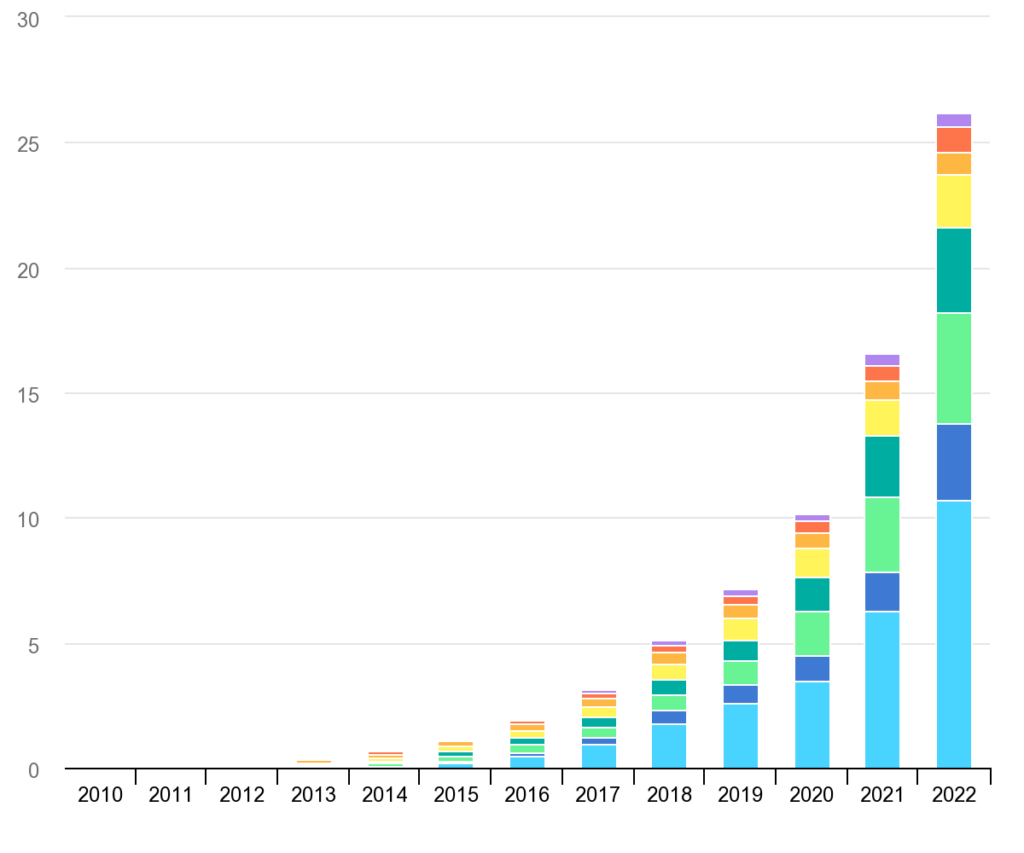Electric vehicle (EV) sales have been growing exponentially in recent years. According to the International Energy Agency (IEA), it took five years from 2012 to 2017 for EV sales to grow from 100,000 to 1 million, and the share of electric cars in total car sales jumped from 9% in 2021 to 14% in 2022, more than 10 times their share in 2017[1].

The exceptional boom in 2021 may be explained by EV markets catching up in the wake of the COVID-19 pandemic. The annual growth rate for electric car sales in 2022 was similar to the average rate over 2015-2018, and the annual growth rate for the global stock of electric cars in 2022 was similar to that of 2021 and over the 2015-2018 period, showing a robust recovery of EV market expansion to pre-pandemic pace[1].
The US is expected to see EV sales grow to reach approximately 29.5% of all new car sales in 2030 from a little more than 500,000 in 2021[3]. Goldman Sachs Research expects EV sales to grow by 32% annually this decade, even as sales of products related to internal combustion engines decline. They forecast sales of EVs to grow to about 73 million units in 2040, up from around 2 million in 2020, and the percentage of EVs in worldwide car sales is expected to rise to 61% from 2% during that span[6].
The global conventional gasoline and diesel light-duty vehicle (LDV) fleet is projected to peak in 2038, and EVs are projected to grow from 0.7% of the global LDV fleet in 2020 to 31% in 2050, reaching 672 million vehicles[2]. The IEA projects EV fleet shares will reach 34% in OECD countries and 28% in non-OECD countries by 2050[2].
The US is the third-largest EV manufacturer, and the transition to EVs has maintained its momentum as the country increasingly develops and adopts policies to accelerate growth in EV. The global EV sales increased by 40-45%, and the US sales rose 4% while overall car sales decreased 13-15% in 2020[7].
In conclusion, the EV market has been growing exponentially in recent years, and projections show that it will continue to grow in the coming decades. The US is expected to see significant growth in EV sales, and the global conventional LDV fleet is projected to peak in 2038.
In terms of progression, there are currently 1.3 billion vehicles in the world. So this means that only 2.5% of current vehicles are electric globally. Electric vehicles have a long way to go before they become the majority with Tesla leading the charge in terms of production. The Cybertruck should add to this value once it’s production starts with 2 million currently reserved.
Citations:
[1] https://www.iea.org/reports/global-ev-outlook-2023/trends-in-electric-light-duty-vehicles
[2] https://www.eia.gov/todayinenergy/detail.php?id=50096
[3] https://evadoption.com/ev-sales/ev-sales-forecasts/
[4] https://www.iea.org/news/demand-for-electric-cars-is-booming-with-sales-expected-to-leap-35-this-year-after-a-record-breaking-2022
[5] https://www.statista.com/outlook/mmo/electric-vehicles/worldwide
[6] https://www.goldmansachs.com/intelligence/pages/electric-vehicles-are-forecast-to-be-half-of-global-car-sales-by-2035.html
[7] https://www.fortunebusinessinsights.com/u-s-electric-vehicle-market-106396
[8] https://www.bls.gov/opub/btn/volume-12/charging-into-the-future-the-transition-to-electric-vehicles.htm
Leave a Reply